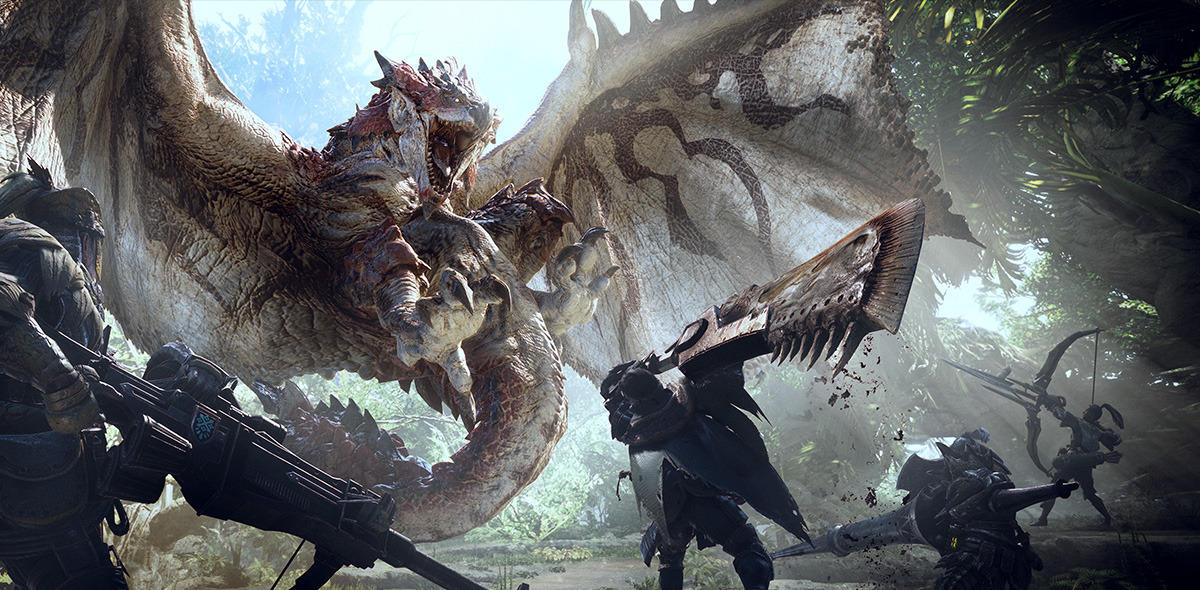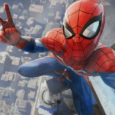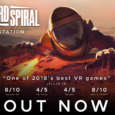There I am, waiting at the canteen in town. A posse of muscular cats begins a choreographed cooking session that will help prepare me for what’s to come. My crew continues to complete their preparations for the hunt ahead. I double check my armor and weapons to ensure that they are correct for the monster we are about to fell. Making a few last minute adjustments to my gear, I check in with my mates and we green up to depart for the quest. The moment our feet hit the ground, we are immersed into the universe of Monster Hunter World.
There is nothing more exhilarating than the thrill of the hunt. Capcom’s Monster Hunter series is synonymous with gaming grinds. The series never deviates away from its gameplay loop but it has always complemented the game’s sense of progression. Repeating the same hunt over and over is common place in this series, so repetition is in its DNA. However, the repetitive nature of prepping, hunting, crafting, and recycle is managed by an incredible 4 player co-op experience.
The phases of the game are pretty standard, but every phase is important.
Phase one is hunting, which I have explained above. Prepping is all about preparing your character for the chosen hunt ahead. If you are going after a fire based T-Rex monster, it might be best to wear some fire resistant armor as well as sporting a water based weapon. This will ensure you can take the beating the monster is about to deal, but ensure you can dish out appropriate damage to it as well.
You acquire weapons and armor by felling beasts. Eradicating fauna to get the crafting parts is Phase 2 of this game. Each monster in Monster Hunter World drops its own sets of materials in which you use to craft new weapons and armor. Each material drop has a somewhat random drop rate percentage, which becomes much less random by focusing on attacking key areas of a monster. Does your next upgrade need the nose bone of a beast? Well it is probably best to attack its face. Do you need the tail of an animal? You guessed it, attack its rear and chop that tail off!
There are 14 weapons in the game, each with their own distinct style and animations. You can expect everything from long ranged bows and machine gun like weapons, to more classic affairs like swords, shields, and giant axes. Every hunter will have their favorite weapon, but the game encourages you to try multiple types, if not all of them. Different weapons each serve their purpose in battle, and with a well-rounded team you can become an unstoppable monster slaying force of nature. Armor is very much the same, each piece offering its own sets of buffs, boosts, resistances, and weaknesses. Each weapon and piece or armor is meticulously designed with care, showcasing its own look and aesthetic. This same care and detail translates into the monsters themselves, each one looking distinguished and personal. Looking at your weapons and armor and remembering the monsters you slew to obtain it, is always a gratifying feeling.
When the monster is slain and the quest wraps up, you will get quest rewards which are a bit more random. Players can attempt to bend the odds in their favor by using a lucky ticket voucher to increase rare drop rates. Just prepare yourself to fight the same beast an upwards of 10-15 times if you are trying to complete a matching armor and weapon set.

This leads us into Phase 3, crafting. The quest is wrapped up, and the target monster has been silenced. There are no level ups and there are no skill trees in Monster Hunter World. Instead, it is time to use your spoils of war to create new duds and pokey things. Everything is predicated on the weapons and armor you craft and use. Senselessly slaying beats will get you no stronger, so it is best to focus on the animals you need parts from. After you have completed your crafting and managing other items you acquired from local fauna in your last hunt, it is time to cycle and do it all over again. There is always a new target to go after, or you can hone your technique on beasts you are familiar with.
You can bring a variety of items on your hunt from healing potions, to health buffs, to traps to snag your targets in. Smoke bombs that spew out health, tainted meets, sleeping concoctions, camouflage ghillie suits, and wing glider suits are all just a taste of the tools you can use. All of them are optional to use, but having some of these can be the trump card you need to turn a ferocious fight around. Never leave home without a few tricks up your sleeve.
Utilizing the environment to your advantage is also a must for the more important hunts. The larger the beast, the more important it is to utilize everything around you to chip health away. Hazards such as poisonous plant pods, falling rocks and boulders, getting wrapped up in vines, or gaining the high ground to jump on the monster and rodeo it into submission are all great techniques for a hunter to master.
 Always come prepared to every fight, no matter how small the target. Once you enter one of the many biomes in Monster Hunter World, you have entered into the ecosystem and the food chain. Monsters will hunt one another, engage in turf wars, and fight in giant kaiju inspired fights that are so well animated that you can’t help but to just sit there and watch the tyrants duke it out in awe. Walking into a zone and squaring off with the targeted beast can lead into a battle royale free-for-all where three gigantic monsters occupy the same area, and none are too happy that you are there as well. These chaotic situations cultivate so many stand up and cheer moments that you will constantly find yourself with a smile on your face.
Always come prepared to every fight, no matter how small the target. Once you enter one of the many biomes in Monster Hunter World, you have entered into the ecosystem and the food chain. Monsters will hunt one another, engage in turf wars, and fight in giant kaiju inspired fights that are so well animated that you can’t help but to just sit there and watch the tyrants duke it out in awe. Walking into a zone and squaring off with the targeted beast can lead into a battle royale free-for-all where three gigantic monsters occupy the same area, and none are too happy that you are there as well. These chaotic situations cultivate so many stand up and cheer moments that you will constantly find yourself with a smile on your face.
The monsters themselves have no health bar. The genius in this is that you have to stay engaged and aware of the monster, it’s changes in attack patterns, and it’s evolving aesthetic as you chip away at the beast. As you give it the beat down, the large animals will begin to slow in speed, stumble or limp, drool at the mouth, sever an appendage, and generate scaring and wounds all over its body. When you begin to see these visual cues, you know you are doing the damage that needs to be done. Monster Hunter World may have an unconventional enemy health system, but that is all part of its DNA. Being aware of your surroundings, recognizing patterns and behaviors, and adapting to the situation are all the marks of a great hunter. The glory comes in many forms, but among its most potent is seeing your progression from fighting a monster for the first time, to fighting it for the 10th time. Your technique improves, and you become stronger, making trips back to old areas feels empowering.
When you enter a zone, the first thing you must do is begin to track your target. Footprints will be everywhere, piles of dung, scratch marks, skid marks, and other visual cues will give you clues on the monster’s whereabouts. As you find more of these in environment clues, your scout-flies (glowing insects that act as the in game GPS system) will begin to lead you towards your target. Whittling away at the beast’s health will have it running away. This will queue up the hunt portion again, where you have to track the beast down again for another showdown. This made me feel like a true hunter, as I was always dialed into my surroundings and looking for little indicators to help me in the fights that await me.
Monster Hunter World is made to be experienced with friends, but the addition of a full story mode, characters, and cut-scenes have added an extra layer that just was never present in the series before. While it is a nice addition, it is far from the focus of this game. Story means a lot to me, so while this one falls short, I hate to even focus on it as a shortcoming of the game. The series has always been about slaying monsters, not about crafting a story with memorable characters. There are many missions and quests that range from fetch quests to the staple genocide of gigantic animals. These story missions or simple quests can be taken on in a solo fashion, as can much of the game, but the game enhances with a good, full party. In this sense it is much like Destiny, where the game can be played in either way. So far I have experienced limited online issues, and have found myself in groups with my buddies and random people alike, with extreme ease.
A big stand out that may seem subtle to some is the music composition. The music, composed by Akihiko Narita and Zhenlan Kang, sets the tone in the most perfect way. As you hunt and track your target the music is subtle almost nonexistent as it allows you to be engulfed and immersed in the world around you. The music comes in with full force as you clash with a giant beast. When you have the monster on the run, the music will decrescendo into a more appropriate trot, while you relocate your target. When you lay eyes on it again, the full orchestra will ramp back up organically into the full sound of the fight music. This dance continues until the monster perishes. Little subtleties like this really elevate the experience from a sound perspective, and the attention to detail pays off in the biggest of ways.
At the 56 hour playtime mark, I wrapped up the main story quest and reached “end game.” To most Monster Hunter pros, this is where the true game begins, and the training wheels are taken off. 100 plus more hours of end game content awaits you, as you slay new monsters, go to new areas, and slay bigger and badder versions of previous beasts. You are sure to have months of content here, and with Capcom suggesting that there will be free DLC and events all year long, it seems we will not be running out of things to kill and make clothes out of, anytime soon.
I have been in a love hate relationship with the Monster Hunter series for a long time. Around the 20 hour mark in most of the games I always hit a grinding wall where I just lose sight of the fun. I reached the 24 hour mark on my second sit down session with this game, and never felt more compelled to play it come that 25th hour. For whatever reason, the gameplay loop and the universe they have created in Monster Hunter World is resonating with me in ways I never thought this series could. While not much has changed in the game, everything feels focused and honed. This is the definitive version of the series, and has a presentation that excels on consoles. Perhaps this series works well on handheld systems thanks to their grindy nature, but there is nothing like seeing the game running on the PS4 displayed on a 4K HDR TV. The series is back where it belongs, on home consoles and in stunning HD. Monster Hunter Worlds is easily the first game of the year contender for 2018, and it is a must play for old fans, and newcomers alike.














